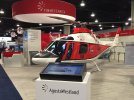Apologies for the late post - moving this thread from April 2015 to Jan 2016

- but it's still a very relevant thread.
I'm hearing rumors from folks that there will be some news in this space at Heli Expo Louisville in February. So lets hope its something positive. I think the UH-72 Lakota, EC-135,and Bell 407 even the AW119 would all be fine trainers. As I understand it the new Bell 505 JetRanger X is also very much in play - it uses the proven dynamic components of the Long Ranger 206-L4 along with a new composite fuselage with an open cabin and state of the art avionics. The HeliSAS certified on the Bell 206L4 is compatible with it as well - operating cost per flight hour well less than the 407, and minimal changes to the FTI and curriculum guide. The full auto profile of the '57 would be preserved.
Some other things seem to be happening with maintenance in the '57 fleet that is bringing this to a head - the FY 2016 budget proposal gives L3 roughly $600K to do overhaul on each TH-57 every 5 years. The actual costs of doing across al three models of TH-57 (TH-57B, TH-57C, and TH-57C-NVG) are closer to $1MM. So basically the Navy is buying the current fleet several times over anyways.
The crux of the issue is whether to do a buy (CNATRA owns the airframes) vs lease model (power by the hour).
It would seem doing the Advanced Helo syllabus in a medium twin with current avionics would pay off in spades at the FRS in that students would already be exposed to employing in something like a UH-72. The TH-57 is a severe step backwards from the T-6B. You want a Replacement Pilot entering the FRS who can think systems, Fly, and employ an aircraft in a tactical environment generally - day, night, unaided, NVG, - more than "get from point A-B on the airways" which is what the HT's still produce.
If the Army is going to do Ab Initio in the UH-72, surely our Student Naval Aviators can handle the move up from safely operating the T-6B solo to an airframe like the UH-72

The MoD (UK) does advanced training in the Bell 412 no problem. Todays simulators can be used to teach the full auto maneuvers with complete fidelity.
Looking forward to what the industry says next month!

 - but it's still a very relevant thread.
- but it's still a very relevant thread.


